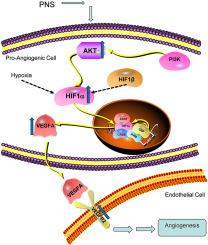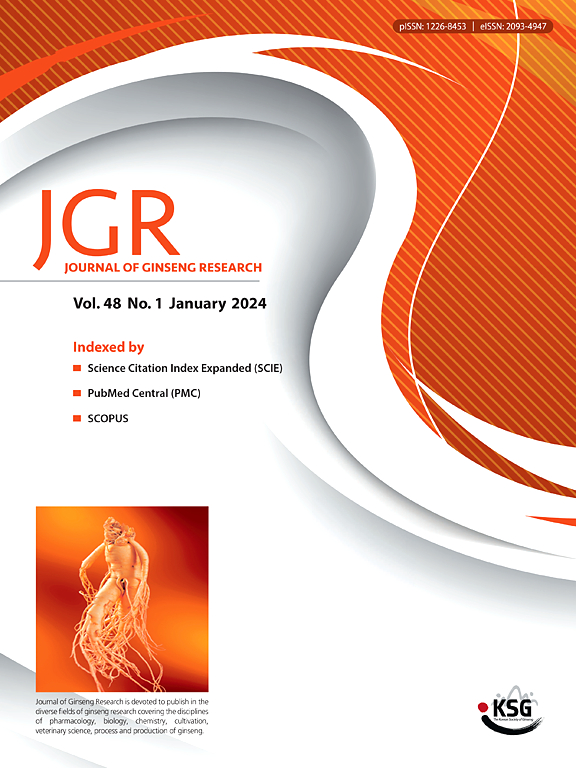三七皂苷能促进脑缺血再灌注损伤后的血管生成
IF 6.8
2区 医学
Q1 CHEMISTRY, MEDICINAL
引用次数: 0
摘要
缺血性中风是一种可导致永久性残疾和死亡的破坏性疾病,而血管生成在缺血性中风患者和动物模型的恢复和存活中发挥着关键作用。三七具有活血化瘀的功效,一直被用作治疗中风疾病的主要药材。然而,三七皂苷在促进血管生成方面的作用尚不明确。本研究旨在探讨由三七皂苷组成的 "雪参通 "注射液(XST)在中风后血管重建中的作用。本研究以 Sprague-Dawley 大鼠为研究对象,建立了大脑中动脉闭塞/再灌注模型,通过腹腔注射 XST 和阳性药物 Dl-3-n-butylphthalide (NBP),观察脑卒中后血管的变化。三苯基氯化四氮唑染色和光学相干断层血管造影证实了 XST 在中风后的保护和促血管生成作用。随后,通过网络药理学和分子对接技术以及实验验证,进一步分析了XST促进血管生成的潜在机制。结果表明,XST能缩小大鼠的脑梗死区域。给药7天或14天后,大鼠脑缺血区的新生血管明显增多。此外,XST 还能激活血管内皮生长因子 A(VEGFA)/血管内皮生长因子受体 2(VEGFR2)和缺氧诱导因子 1(HIF-1)信号通路。XST 可通过影响 HIF1-α/VEGFA/VEGFR2 信号通路促进中风后血管生成。本文章由计算机程序翻译,如有差异,请以英文原文为准。

Panax notoginseng saponins promotes angiogenesis after cerebral ischemia-reperfusion injury
Background
Ischemic stroke is a devastating disease that can result in permanent disability and death, and angiogenesis plays a critical role in the recovery and survival of patients and animal models of ischemic stroke. Panax notoginseng has been used as a key herb in the treatment of stroke diseases due to its effect in promoting blood circulation and removing blood stasis. However, the role of Panax notoginseng saponins, in promoting angiogenesis is unclear.
Purpose
This study is aimed to investigate the effect of Xueshuantong (XST) injection, composed of Panax notoginseng saponins in post-stroke revascularization.
Method
In the present study, a middle cerebral artery occlusion/reperfusion model was established in Sprague-Dawley rats, with XST and the positive drug Dl-3-n-butylphthalide (NBP) administered via intraperitoneal injection to observe vascular changes after stroke. The protective and pro-angiogenic effects of XST after stroke were demonstrated by Triphenyltetrazolium chloride staining and optical coherence tomography angiography. Subsequently, network pharmacology and molecular docking techniques, as well as in vitro experimental validation, were used to further analyze the potential mechanism by which XST promotes angiogenesis.
Results
The results showed that XST could reduce the cerebral infarction region in rats. And the neovascularization in the ischemic area of the rat brain significantly increased after 7 or 14 days of XST administration. Furthermore, XST could activate the vascular endothelial growth factor A (VEGFA)/vascular endothelial growth factor receptor 2 (VEGFR2), and hypoxia-inducible factor 1 (HIF-1) signaling pathways.
Conclusion
XST may promote post-stroke angiogenesis by affecting the HIF1-α/VEGFA/VEGFR2 signaling pathways.
求助全文
通过发布文献求助,成功后即可免费获取论文全文。
去求助
来源期刊

Journal of Ginseng Research
CHEMISTRY, MEDICINAL-INTEGRATIVE & COMPLEMENTARY MEDICINE
CiteScore
11.40
自引率
9.50%
发文量
111
审稿时长
6-12 weeks
期刊介绍:
Journal of Ginseng Research (JGR) is an official, open access journal of the Korean Society of Ginseng and is the only international journal publishing scholarly reports on ginseng research in the world. The journal is a bimonthly peer-reviewed publication featuring high-quality studies related to basic, pre-clinical, and clinical researches on ginseng to reflect recent progresses in ginseng research.
JGR publishes papers, either experimental or theoretical, that advance our understanding of ginseng science, including plant sciences, biology, chemistry, pharmacology, toxicology, pharmacokinetics, veterinary medicine, biochemistry, manufacture, and clinical study of ginseng since 1976. It also includes the new paradigm of integrative research, covering alternative medicinal approaches. Article types considered for publication include review articles, original research articles, and brief reports.
JGR helps researchers to understand mechanisms for traditional efficacy of ginseng and to put their clinical evidence together. It provides balanced information on basic science and clinical applications to researchers, manufacturers, practitioners, teachers, scholars, and medical doctors.
 求助内容:
求助内容: 应助结果提醒方式:
应助结果提醒方式:


